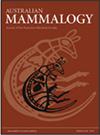Intraspecific variation in testis organisation and sperm head morphology of the delicate mouse (Pseudomys delicatulus): its possible causes and consequences
IF 1.2
4区 生物学
Q3 ZOOLOGY
引用次数: 1
Abstract
The delicate mouse (Pseudomys delicatulus) ranges from Queensland to northern Western Australia. In this study the morphology of the cellular organisation of the testis and cauda epididymal spermatozoa are compared. Individuals from the mainland of the Northern Territory and Western Australia invariably have only 60–70% of the testes composed of seminiferous tubules with the interstitial tissue between the tubules containing abundant lipid rich Leydig cells, whereas the cauda epididymal sperm have highly polymorphic, often pear-shaped, heads and basally attached tails. In individuals from Queensland the seminiferous tubules make up approximately 80% of the testis, whereas in the cauda epididymides the sperm populations are generally less variable and have bilaterally flattened heads with the tail attached to the lower concave surface. These differences in the morphology of the delicate mouse testis and spermatozoa in these two geographic regions suggest differences in intensity of intermale sperm competition, with individuals from northern Western Australia and the mainland of the Northern Territory exhibiting monogamy whereas those from Queensland may exhibit some degree of intermale sperm competition and hence possibly have a polyandrous or promiscuous mating system. These findings support the suggestion that P. delicatulus, as currently recognised, contains at least one cryptic species.娇嫩小鼠(Pseudomys delicatulus)睾丸组织和精子头形态的种内变异:可能的原因和后果
这种精致的老鼠(Pseudomys delicatulus)分布在昆士兰到西澳大利亚北部。本研究比较了睾丸和附睾尾精子的细胞组织形态。来自北领地和西澳大利亚大陆的个体总是只有60-70%的睾丸由输精管组成,输精管之间的间质组织含有丰富的富含脂质的间质细胞,而尾附睾精子具有高度多态性,通常呈梨形,头部和基部附着的尾巴。在来自昆士兰的个体中,精管约占睾丸的80%,而在附睾尾中,精子群体通常变化较少,双侧头部扁平,尾部附着在较低的凹表面。在这两个地理区域,精致的小鼠睾丸和精子形态的差异表明雄性间精子竞争的强度不同,来自西澳大利亚北部和北领地大陆的个体表现为一夫一妻制,而来自昆士兰的个体可能表现出一定程度的雄性间精子竞争,因此可能有一个多夫制或滥交的交配系统。这些发现支持了P. delicatulus,如目前所认识的,包含至少一个隐种的建议。
本文章由计算机程序翻译,如有差异,请以英文原文为准。
求助全文
约1分钟内获得全文
求助全文
来源期刊

Australian Mammalogy
ZOOLOGY-
CiteScore
2.50
自引率
8.30%
发文量
26
期刊介绍:
Australian Mammalogy is a major journal for the publication of research in all branches of mammalogy. The journal’s emphasis is on studies relating to Australasian mammals, both native and introduced, and includes marine mammals in the Antarctic region. Subject areas include, but are not limited to: anatomy, behaviour, developmental biology, ecology, evolution, genetics, molecular biology, parasites and diseases of mammals, physiology, reproductive biology, systematics and taxonomy.
Australian Mammalogy is for professional mammalogists, research scientists, resource managers, consulting ecologists, students and amateurs interested in any aspects of the biology and management of mammals.
Australian Mammalogy began publication in 1972 and is published on behalf of the Australian Mammal Society.
 求助内容:
求助内容: 应助结果提醒方式:
应助结果提醒方式:


